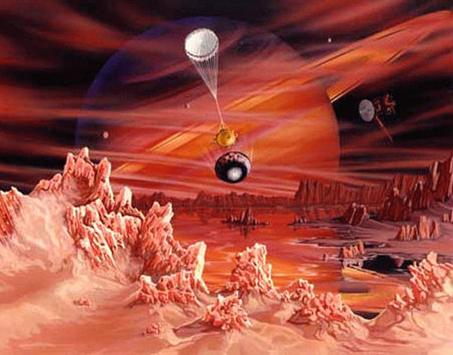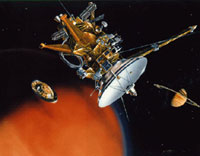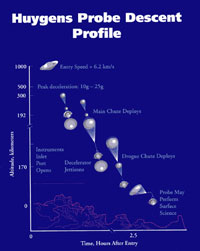|
From the Cassini-Huygens Website - Huygens Mission to Titan:
Back to
Astrobiology
This page is copied directly from the
Huygens website! It is to serve as a sort of mirror in case the Huygens
page becomes old and unlisted.
 |
This artist's conception shows Titan's surface with Saturn appearing
dimly in the background through Titan's thick atmosphere of mostly
nitrogen and methane. The Cassini spacecraft flies overhead with its
high-gain antenna pointed at the Huygens probe as it nears the surface.
Titan's surface may hold lakes of liquid ethane and methane, sprinkled
over a thin veneer of frozen methane and ammonia. Most of the
brownish-orange color comes from more heavily processed hydrocarbons
present in Titan's atmosphere and on its surface. Artistic license has
been used to exaggerate the size of the orbiter, the sharpness of the
icy features, the tilt of Saturn's rings, and the visibility of the
planet through Titan's atmosphere. By Craig Attebery |
The European Space Agency's
Huygens probe ushered in 2005 with its landmark mission at Titan. After a
seven-year journey bolted to the side of the Cassini Orbiter, Huygens was set
free on Dec. 25, 2004. The Probe coasted for 21 days en route to Titan.
Probe Separation and Transit to Titan
Prior to the probe's separation from the orbiter, the triplicate "coast" timer,
or Mission Timer Unit (MTU) was loaded with the precise time necessary to turn
on the probe systems (about 4 hours before the initial encounter with Titan's
atmosphere). Then the probe separated flawlessly from the orbiter. Cassini
turned and imaged Huygens repeatedly as it set out on its 21-day coast to Titan,
with no systems active except for its wake-up timer.
Huygens separated from Cassini at 30 centimeters (about 12 inches) per second
and a spin rate of seven revolutions per minute to ensure stability during the
coast and entry phase. This rate was confirmed by the Magnetometer instrument on
the Cassini Orbiter. Five days following the release of the probe, Cassini
performed a deflection maneuver. This placed the orbiter on the proper
trajectory - missing Titan instead of impacting - to collect Huygens' data
during the probe mission.
Titan's nitrogen-rich atmosphere extends 10 times further into space than
Earth's atmosphere. This means the outer fringes of Titan's atmosphere reach
almost 600 kilometers (almost 400 miles) into space. When the probe detected
this region of Titan's atmosphere, the deceleration set off a sequence of events
leading to its perfect parachute descent.
Huygens was equipped with six science instruments designed to study the content
and dynamics of Titan's atmosphere and collect data and images on the surface.

All times are given in
Spacecraft Event Time (SCET),
Universal Coordinated Time (UTC)
|
Probe Release:
December 25, 2004 02:00 UTC
|
Probe entry at Titan:
January 14, 2005 11:04 UTC
|
Speed at Entry:
6 kilometers per second
|
Impact Speed:
5 meters per second |
Mission Duration:
2 hr, 27 min, 13 sec descent, plus
1 hr, 12 min, 9 sec surface |
Altitude of Cassini during the Huygens
Mission:
60,000 kilometers |
Data rate to Cassini Orbiter:
8 kilobits per second |
Total Battery Capacity of Probe =
1800 Watt-hours |
|
Descent
Through Titan's Atmosphere
Huygens made a parachute-assisted descent through Titan's atmosphere,
collecting data as the parachutes slowed the probe from super sonic
speeds. Five batteries onboard the probe were originally sized for a
Huygens mission duration of 153 minutes, corresponding to a maximum
descent time of 2.5 hours plus a half hour or more on Titan's surface.
In fact, they lasted much longer than that. These batteries were capable
of generating a total of 1800 Watt-hours of electrical power.
The probe's radio link was activated early in the descent phase, during
time the orbiter was flying overhead, "listening" for the probe. Not
long after the end of this four-hour communications window, Cassini's
high-gain antenna (HGA) turned away from Titan and pointed toward Earth.
| This artist's conception of the Cassini orbiter shows the
Huygens probe separating to enter Titan's atmosphere. After
separation, the probe drifts for about three weeks until
reaching its destination, Titan. Equipped with a variety of
scientific sensors, the Huygens probe will spend 2-2.5 hours
descending through Titan's dense, murky atmosphere of nitrogen
and carbon-based molecules, beaming its findings to the distant
Cassini orbiter overhead. The probe could continue to relay
information for up to 30 minutes after it lands on Titan's
frigid surface, after which the orbiter passes beneath the
horizon as seen from the probe. |
 |
The peak heat-flux was
expected in the altitude range below 350 kilometers (217 miles) down to
220 kilometers (137 miles), where Huygens rapidly decelerated from about
21,600 kilometers (13,424 miles) per hour to 1,440 kilometers (895
miles) per hour in less than two minutes.
At this speed, the parachute deployment sequence initiated, starting
with a mortar pulling out a Pilot Parachute which, in turn, pulled away
the aft cover and deployed the Main Parachute. After inflation of the
8.3 meter (27.2 foot) diameter main parachute, the front shield was
released to fall from the Descent Module. Then, after a 30 second delay
built into the sequence to ensure that the shield was sufficiently far
away to avoid instrument contamination, the Gas Chromatograph Mass
Spectrometer (GCMS) and Aerosol Collector and Pyrolyser (ACP) inlet
ports opened and the Huygens Atmospheric Structure Instrument (HASI)
boom deployed. The Descent Imager/Spectral Radiometer (DISR) cover was
ejected two minutes later.
The main parachute was sized to pull the Descent Module safely out of
the front shield. It was jettisoned after 15 minutes to avoid a
protracted descent, and a smaller 3-meter (10-foot) diameter parachute
was deployed. The descent lasted about two and a half hours.
|
 |
During its descent,
Huygens' camera returned more than 750 images, while the Probe's other
five instruments sampled Titan's atmosphere to help determine its
composition and structure. Huygens collected 2 hours, 27 minutes, 13
seconds of descent data, and 1 hour, 12 minutes, 9 seconds of surface
data, which turned out to be far more surface data than was ever
expected.
Every bit of data from Huygens was successfully relayed to the Cassini
Orbiter passing overhead, with the exception of a redundant stream
called "Chain A." Chain A's radio frequency was based on Huygens' Ultra
Stable Oscillator, designed for the Doppler Wind Experiment. While this
signal was not received aboard Cassini, it was received on Earth, thanks
to Radio Scientists using Earth-based radio telescopes at
Green
Bank and
Parkes. They were actually able to capture the tiny signal, now
being called "Chain C," directly from Titan! Telemetry data from Huygens
was stored onboard Cassini's Solid State recorders (SSR) for playback to
Earth. Huygens is managed by the European Space Agency. Complete details
on the mission objectives and science can be found on the
ESA Huygens Site.
|
Back to Top |

